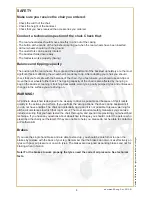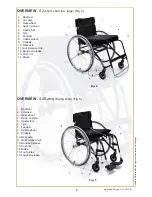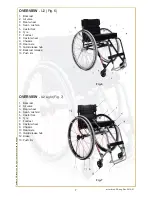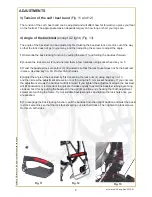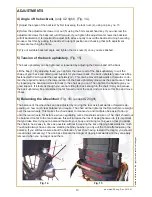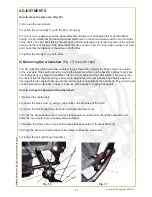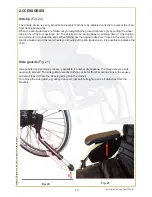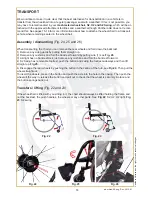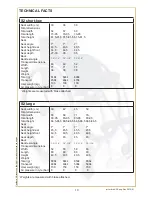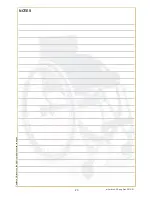
10
art.nr.bruk-S2-eng, Rev. 2015-01
Panthera
AB reserves the right to make technical changes
ADJUSTMENTS
4) Angle of the backrest
, (only U2 light)
(Fig. 14).
1)
Adjust the angle of the backrest by first loosening the lock nuts (4), using cap key no. 13,
2)
Screw the adjustment screws in or out (5) using the 5mm socket head key. If you unscrew the
adjustment screws the backrest will tilt forward. If you tighten the adjustment screws the backrest
will tilt backwards. It is important to adjust both sides equally to avoid the backrest tubing becoming
crooked. Test this by putting the backrest in upright position and checking that both adjustment
screws are touching the frame.
3)
Try out suitable backrest angle and tighten the lock nuts (4) once you are satisfied..
5) Tension of the back upholstery.
(Fig. 15)
The back upholstery can be tightened or loosened by adjusting the Velcro band at the back.
Lift the flap (1). By adjusting these you can form the lower part of the back upholstery to suit the
shape of your back and obtain good support for your lower back. The back upholstery also has a flap
fastened with Velcro under the seat upholstery (2). This can be moved backwards or forwards to ob-
tain the required tension in the lower section of the back upholstery (known as the seat bucket). Start
by loosening the band and sit as far back in the chair as you can. Then tighten the band to give you
good support. If it feels as though you are not sitting far back enough in the chair it may be because
the back upholstery flap is fastened too far forward under the seat. Undo or loosen this flap and move
it back.
6) Balancing the wheelchair
(Fig. 16)
(except U2 light)
The balance of the wheelchair can be adjusted by moving the rear axle backwards or forwards de-
pending on how much ‘rear balance’ you require. The chair will be lighter at the front with more weight
over the rear wheels. This makes the chair easier to manoeuvre and it will also be easier to tip up
onto the rear wheels, for instance, when negotiating curbs, thresholds and so on. The chair should not
be balanced too far to the rear because this will increase the risk of tipping backwards. It is important
that you take time trying out a balance that suits your body and driving techniques so that you adapt
the chair to be as easy to drive as possible, without increasing the risk of tipping backwards too much.
You should always have someone standing behind you when you try out the chair after adjusting the
balance. If you still feel unsure about the balance of your chair having tested it thoroughly you should
use anti-tips (accessory). The anti-tips eliminate the danger of tipping backwards and they are easily
removed when you no longer need them.
Fig. 14
Fig. 15




